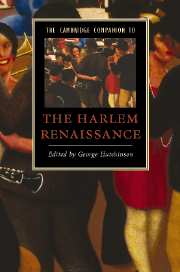2 - The Renaissance and the Vogue
from Part I: - Foundations of The Harlem Renaissance
Published online by Cambridge University Press: 28 July 2007
Summary
“It was the period when the Negro was in vogue.” These words introduce readers of The Big Sea, a 1940 autobiography by Langston Hughes, to the era known today as the Harlem Renaissance, which commenced in 1924, and was the first significant literary and cultural movement in African American history. This sentence by Hughes captures what was at once transcendent and dispiriting about the era. The Harlem Renaissance was a moment when blackness was celebrated; but to be in vogue is to be in fashion, and fashions always die. As an era concerned with the vitalization as well as with the demise of African American identity, the Harlem Renaissance was an era best characterized by its contradictions: every point of celebration was also a source of contention. This chapter begins with a discussion of the contradictions at the root of the ideological issues that occasioned what was both glorious and grim about Harlem in the 1920s. But before we can get to the achievements of the Harlem Renaissance, we must confront the problems inherent in the term “Harlem Renaissance” itself.
Was the Harlem Renaissance an actual renaissance? Scholarship on this period supports competing points of view. Webster's New World Dictionary defines a “renaissance” as a “rebirth” or “revival.” Some historians and critics believe that what took place during the Harlem Renaissance years was not a rebirth, as such, but only another stage in the evolution of African and African American art that had begun with the inception of African presence in America. While it is true that African and African American art forms never died – new ones were created and evolved even during slavery – a particular black American identity was born after Emancipation, and that was the “New Negro.” The Harlem Renaissance is also known as the New Negro Movement.
- Type
- Chapter
- Information
- The Cambridge Companion to the Harlem Renaissance , pp. 28 - 40Publisher: Cambridge University PressPrint publication year: 2007
- 9
- Cited by



